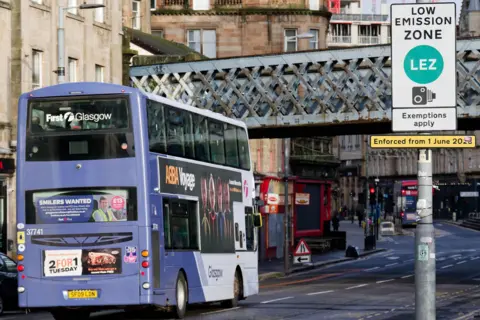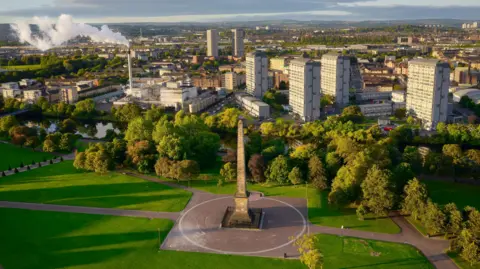 Getty Images
Getty ImagesThe levels of air pollution from vehicles in Glasgow’s city centre low-emission zone fell by more than areas outside it last year, newly released data shows.
The council’s air quality report for 2023 shows a 20% drop in nitrogen dioxide (NO2) levels in the city centre and LEZ area.
This was more than the reduction in areas outside the city centre, which saw a 15.3% drop in concentrations of the harmful air pollutant.
Some areas within the city centre are still breaching the legal limits for NO2 pollution but the council said the results for the first seven months of the LEZ were “really encouraging”.

Nitrogen dioxide is a gas mainly produced during the combustion of fossil fuels and is the main pollutant from motor vehicles, especially those with diesel engines.
The LEZ, which began in June 2023, restricts access to the city centre zone for the most polluting vehicles.
Levels of NO2 pollution have been on a downward trend in recent years as a result of general improvements in vehicle emissions and the introduction of a LEZ for scheduled bus services in 2018.
They dropped significantly in 2020 due to Covid travel restrictions and, despite an increase in 2021, have remained below pre-pandemic rates since.
Monitoring of NO2 is carried out using a combination of automatic stations and diffusion tubes.
Use of diffusion tubes allows monitoring at more locations but is less accurate.
 Getty Images
Getty ImagesThe council said two locations within the LEZ continued to record levels of NO2 above permitted levels.
Gordon Street, outside Glasgow Central railway station, which is mainly used as a taxi rank, was one of the locations that exceeded the target.
Taxis have been given more time to comply with the LEZ rules and 778 exemptions were issued for the first year.
Another location, under the railway bridge at Heilanman’s Umbrella, also breached the targets.
The council said this was due to “poor dispersion” of the pollution.
However, as it is a busy public area, the council said it would continue to monitor and report figures.
While all the automatic monitoring stations met legal requirements, Hope Street, which is within the LEZ, only marginally met the NO2 target.
The data will be presented to Glasgow City Council’s net zero committee on 24 September in its annual air quality progress report.
 Getty Images
Getty ImagesBy law, revenue from fines for uncompliant vehicles entering the LEZ must be spent on projects to meet net-zero and clean air targets.
In total, the LEZ brought in about £1m in the year to April but operating costs reduced the amount available to £747,511.
Glasgow City Council has now announced a £250,000 fund to give grants to local organisations who have projects to “improve air quality and reduce emissions”.
A further £250,000 has been made available to “city-wide tree planting and greening projects” as well as a tree sponsorship scheme.
The council said projects would help improve air quality and local biodiversity and help Glasgow achieve “Tree City of the World status” – a United Nations partnered programme that encourages cities to plant trees.
The remaining £247,511 will be retained for future operational costs, with any surplus allocated back to projects such as tree planting.

